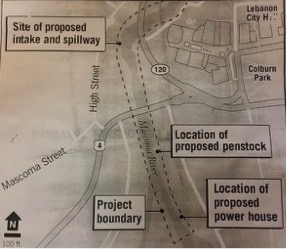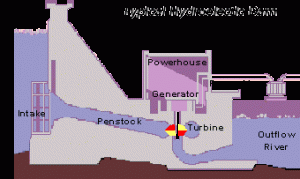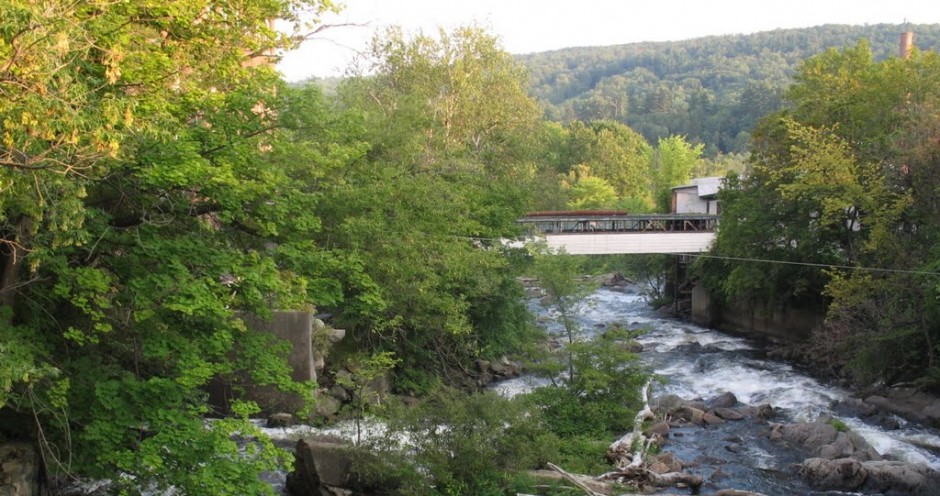The Downtown Lebanon Sight
 The dam that is being proposed for on the Mascoma River in downtown Lebanon, New Hampshire would be installed and operated by Grafton Hydro L.L.C. The dam itself would be a 110-foot long concrete structure with a 60-foot pneumatic crest spillway. With dams breaching water flows over the spillway, so in the case of this dam the water flow would be 60 feet wide, with 50 feet of the whole structure having no water flowing over. A 1,200-foot long steel penstock, which is essentially a large 7-foot diameter pipe, will act to draw water flow from the location of the dam to the power house where it would drive a 2,000 horsepower turbine. The penstock will lead to a portion of the water flow bypassing the section of the river between the dam and the turbine. The power house is proposed to be a 40-foot by 30-foot building where, in addition to the turbine, a 1,500 kilowatt generator will also be located. The resulting impoundment, or body of water, of the damn is expected to be around 2 acres in surface area. The total volume of the impoundment is predicted to be 10 acre-feet which suggests that over the two acre area of the impoundment water would be an average of 5 feet deep. To put the scale of the impoundment into a more relative measure, it would contain around 3 million gallons of water at normal flow rates. Tom Tarpey, of Grafton Hydro L.L.C., also noted of the possibility for fish ladders being included in the project that would enable American Eel to traverse the dam.
The dam that is being proposed for on the Mascoma River in downtown Lebanon, New Hampshire would be installed and operated by Grafton Hydro L.L.C. The dam itself would be a 110-foot long concrete structure with a 60-foot pneumatic crest spillway. With dams breaching water flows over the spillway, so in the case of this dam the water flow would be 60 feet wide, with 50 feet of the whole structure having no water flowing over. A 1,200-foot long steel penstock, which is essentially a large 7-foot diameter pipe, will act to draw water flow from the location of the dam to the power house where it would drive a 2,000 horsepower turbine. The penstock will lead to a portion of the water flow bypassing the section of the river between the dam and the turbine. The power house is proposed to be a 40-foot by 30-foot building where, in addition to the turbine, a 1,500 kilowatt generator will also be located. The resulting impoundment, or body of water, of the damn is expected to be around 2 acres in surface area. The total volume of the impoundment is predicted to be 10 acre-feet which suggests that over the two acre area of the impoundment water would be an average of 5 feet deep. To put the scale of the impoundment into a more relative measure, it would contain around 3 million gallons of water at normal flow rates. Tom Tarpey, of Grafton Hydro L.L.C., also noted of the possibility for fish ladders being included in the project that would enable American Eel to traverse the dam.

(Taken from http://water.usgs.gov/edu/hyhowworks.html)
Proposed Developments to Existing Mascoma Lake Dam
The current dam structure at Mascoma Lake would continue to be used by Grafton Hydro L.L.C. The main development at this sight would be a 40-foot by 30-foot power house structure to house four 150 horsepower turbines that would drive four 150-kilowatt generators. Tom Tarpey claims that the size of current impoundment area of the dam, namely Mascoma Lake, would be unaffected by the developments. The two hydroelectric sights are estimated to produce around 6,500 megawatt-hours of power annually.
The information on this page was gathered through speaking with Tom Tarpey and from The Federal Register.
